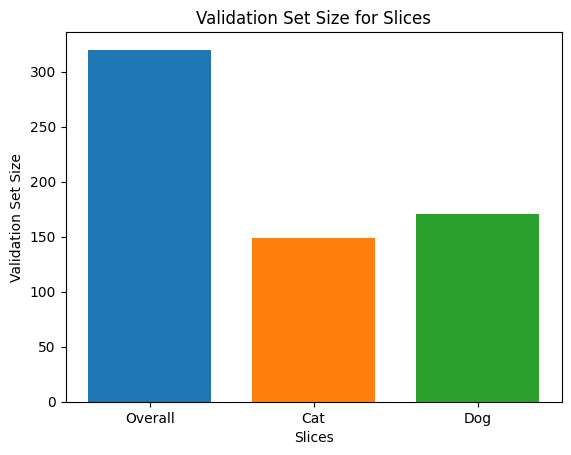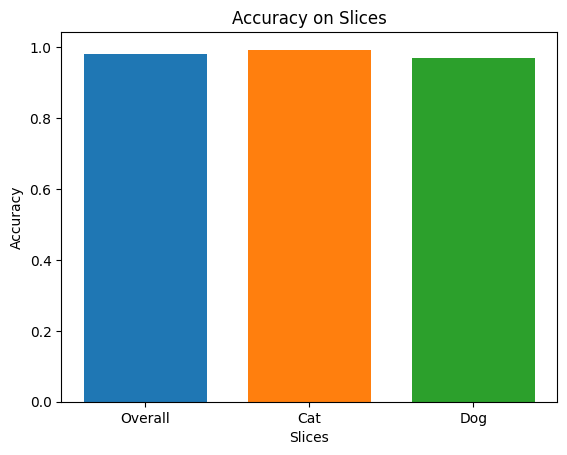This "standalone" notebook demonstrates using the Model Card Toolkit without the TFX/MLMD context.
 View on TensorFlow.org View on TensorFlow.org
|
 Run in Google Colab Run in Google Colab
|
 View on GitHub View on GitHub
|
 Download notebook Download notebook
|
Objective
This notebook demonstrates how to generate a Model Card using the Model Card Toolkit in a Jupyter/Colab environment. You can learn more about model cards at https://modelcards.withgoogle.com/about
We are using a Keras model in this demo. But the logic below also applies to other ML frameworks in general.
Setup
We first need to a) install and import the necessary packages, and b) download the data.
Upgrade Pip and install the Model Card Toolkit
pip install --upgrade pippip install 'model-card-toolkit>=1.0.0'pip install 'tensorflow>=2.3.1'pip install 'tensorflow-datasets>=4.8.2'
Did you restart the runtime?
If you are using Google Colab, the first time that you run the cell above, you must restart the runtime (Runtime > Restart runtime ...). This is because of the way that Colab loads packages.
Imports
import tensorflow as tf
import numpy as np
import model_card_toolkit as mct
from model_card_toolkit.documentation.examples import cats_vs_dogs
from model_card_toolkit.utils.graphics import figure_to_base64str
import tempfile
import matplotlib.pyplot as plt
from IPython import display
import requests
import os
import zipfile
Model
We will use a pretrained model with architecture based off MobileNetV2, a popular 16-layer image classification model. Our model has been trained to distinguish between betweens cats and dogs using the Cats vs Dogs dataset. The model training was based on the TensorFlow transfer learning tutorial.
URL = 'https://storage.googleapis.com/cats_vs_dogs_model/cats_vs_dogs_model.zip'
BASE_PATH = tempfile.mkdtemp()
ZIP_PATH = os.path.join(BASE_PATH, 'cats_vs_dogs_model.zip')
MODEL_PATH = os.path.join(BASE_PATH,'cats_vs_dogs_model')
r = requests.get(URL, allow_redirects=True)
open(ZIP_PATH, 'wb').write(r.content)
with zipfile.ZipFile(ZIP_PATH, 'r') as zip_ref:
zip_ref.extractall(BASE_PATH)
model = tf.keras.models.load_model(MODEL_PATH)
WARNING:tensorflow:SavedModel saved prior to TF 2.5 detected when loading Keras model. Please ensure that you are saving the model with model.save() or tf.keras.models.save_model(), *NOT* tf.saved_model.save(). To confirm, there should be a file named "keras_metadata.pb" in the SavedModel directory. WARNING:tensorflow:SavedModel saved prior to TF 2.5 detected when loading Keras model. Please ensure that you are saving the model with model.save() or tf.keras.models.save_model(), *NOT* tf.saved_model.save(). To confirm, there should be a file named "keras_metadata.pb" in the SavedModel directory. 2023-10-03 09:12:20.736066: W tensorflow/core/common_runtime/gpu/gpu_device.cc:1960] Cannot dlopen some GPU libraries. Please make sure the missing libraries mentioned above are installed properly if you would like to use GPU. Follow the guide at https://www.tensorflow.org/install/gpu for how to download and setup the required libraries for your platform. Skipping registering GPU devices...
Dataset
In the cats-vs-dogs dataset, label=0 corresponds to cats while label=1 corresponds to dogs.
def compute_accuracy(data):
x = np.stack(data['examples'])
y = np.asarray(data['labels'])
_, metric = model.evaluate(x, y)
return metric
examples = cats_vs_dogs.get_data()
print('num validation examples:', len(examples['combined']['examples']))
print('num cat examples:', len(examples['cat']['examples']))
print('num dog examples:', len(examples['dog']['examples']))
num validation examples: 320 num cat examples: 149 num dog examples: 171 2023-10-03 09:12:30.081069: W tensorflow/core/kernels/data/cache_dataset_ops.cc:854] The calling iterator did not fully read the dataset being cached. In order to avoid unexpected truncation of the dataset, the partially cached contents of the dataset will be discarded. This can happen if you have an input pipeline similar to `dataset.cache().take(k).repeat()`. You should use `dataset.take(k).cache().repeat()` instead.
accuracy = compute_accuracy(examples['combined'])
cat_accuracy = compute_accuracy(examples['cat'])
dog_accuracy = compute_accuracy(examples['dog'])
10/10 [==============================] - 2s 77ms/step - loss: 0.0794 - binary_accuracy: 0.9812 5/5 [==============================] - 1s 74ms/step - loss: 0.0608 - binary_accuracy: 0.9933 6/6 [==============================] - 0s 65ms/step - loss: 0.0956 - binary_accuracy: 0.9708
Use the Model Card Toolkit
Initialize the Model Card Toolkit
The first step is to initialize a ModelCardToolkit object, which maintains assets including a model card JSON file and model card document. Call ModelCardToolkit.scaffold_assets() to generate these assets and return a ModelCard object.
# https://github.com/tensorflow/model-card-toolkit/blob/master/model_card_toolkit/model_card_toolkit.py
model_card_dir = tempfile.mkdtemp()
toolkit = mct.ModelCardToolkit(model_card_dir)
# https://github.com/tensorflow/model-card-toolkit/blob/master/model_card_toolkit/model_card.py
model_card = toolkit.scaffold_assets()
Annotate the Model Card
The ModelCard object returned by scaffold_assets() has many fields that can be directly modified. These fields are rendered in the final generated Model Card document. For a comprehensive list, see model_card.py. See the documentation for more details.
Text Fields
Model Details
model_card.model_details contains many basic metadata fields such as name, owners, and version. You can provide a description for your model in the overview field.
model_card.model_details.name = 'Fine-tuned MobileNetV2 Model for Cats vs. Dogs'
model_card.model_details.overview = (
'This model distinguishes cat and dog images. It uses the MobileNetV2 '
'architecture (https://arxiv.org/abs/1801.04381) and is trained on the '
'Cats vs Dogs dataset '
'(https://www.tensorflow.org/datasets/catalog/cats_vs_dogs). This model '
'performed with high accuracy on both Cat and Dog images.'
)
model_card.model_details.owners = [
mct.Owner(name='Model Cards Team', contact='model-cards@google.com')
]
model_card.model_details.version = mct.Version(name='v1.0', date='08/28/2020')
model_card.model_details.references = [
mct.Reference(reference='https://www.tensorflow.org/guide/keras/transfer_learning'),
mct.Reference(reference='https://arxiv.org/abs/1801.04381'),
]
model_card.model_details.licenses = [mct.License(identifier='Apache-2.0')]
model_card.model_details.citations = [mct.Citation(citation='https://github.com/tensorflow/model-card-toolkit/blob/master/model_card_toolkit/documentation/examples/Standalone_Model_Card_Toolkit_Demo.ipynb')]
Quantitative Analysis
model_card.quantitative_analysis contains information about a model's performance metrics.
Below, we create some synthetic performance metric values for a hypothetical model built on our dataset.
model_card.quantitative_analysis.performance_metrics = [
mct.PerformanceMetric(type='accuracy', value=str(accuracy)),
mct.PerformanceMetric(type='accuracy', value=str(cat_accuracy), slice='cat'),
mct.PerformanceMetric(type='accuracy', value=str(dog_accuracy), slice='Dog'),
]
Considerations
model_card.considerations contains qualifying information about your model - what are the appropriate use cases, what are limitations that users should keep in mind, what are the ethical considerations of application, etc.
model_card.considerations.use_cases = [
mct.UseCase(description='This model classifies images of cats and dogs.')
]
model_card.considerations.limitations = [
mct.Limitation(description='This model is not able to classify images of other classes.')
]
model_card.considerations.ethical_considerations = [mct.Risk(
name=
'While distinguishing between cats and dogs is generally agreed to be '
'a benign application of machine learning, harmful results can occur '
'when the model attempts to classify images that don’t contain cats or '
'dogs.',
mitigation_strategy=
'Avoid application on non-dog and non-cat images.'
)]
Graph Fields
It's often best practice for a report to provide information on a model's training data, and its performance across evaluation data. Model Card Toolkit allows users to encode this information in visualizations, rendered in the Model Card.
model_card has three sections for graphs -- model_card.model_parameters.data.train.graphics for training dataset statistics, model_card.model_parameters.data.eval.graphics for evaluation dataset statistics, and model_card.quantitative_analysis.graphics for quantitative analysis of model performance.
Graphs are stored as base64 strings. If you have a matplotlib figure, you can convert it to a base64 string with model_card_toolkit.utils.graphics.figure_to_base64str().
# Validation Set Size Bar Chart
fig, ax = plt.subplots()
width = 0.75
rects0 = ax.bar(0, len(examples['combined']['examples']), width, label='Overall')
rects1 = ax.bar(1, len(examples['cat']['examples']), width, label='Cat')
rects2 = ax.bar(2, len(examples['dog']['examples']), width, label='Dog')
ax.set_xticks(np.arange(3))
ax.set_xticklabels(['Overall', 'Cat', 'Dog'])
ax.set_ylabel('Validation Set Size')
ax.set_xlabel('Slices')
ax.set_title('Validation Set Size for Slices')
validation_set_size_barchart = figure_to_base64str(fig)

# Acuracy Bar Chart
fig, ax = plt.subplots()
width = 0.75
rects0 = ax.bar(0, accuracy, width, label='Overall')
rects1 = ax.bar(1, cat_accuracy, width, label='Cat')
rects2 = ax.bar(2, dog_accuracy, width, label='Dog')
ax.set_xticks(np.arange(3))
ax.set_xticklabels(['Overall', 'Cat', 'Dog'])
ax.set_ylabel('Accuracy')
ax.set_xlabel('Slices')
ax.set_title('Accuracy on Slices')
accuracy_barchart = figure_to_base64str(fig)

Now we can add them to our ModelCard.
model_card.model_parameters.data.append(mct.Dataset())
model_card.model_parameters.data[0].graphics.collection = [
mct.Graphic(name='Validation Set Size', image=validation_set_size_barchart),
]
model_card.quantitative_analysis.graphics.collection = [
mct.Graphic(name='Accuracy', image=accuracy_barchart),
]
Generate the Model Card
Let's generate the Model Card document. Available formats are stored at model_card_toolkit/template. Here, we will demonstrate the HTML and Markdown formats.
First, we need to update the ModelCardToolkit with the latest ModelCard.
toolkit.update_model_card(model_card)
Now, the ModelCardToolkit can generate a Model Card document with ModelCardToolkit.export_format().
# Generate a model card document in HTML (default)
html_doc = toolkit.export_format()
# Display the model card document in HTML
display.display(display.HTML(html_doc))
You can also output a Model Card in other formats, like Markdown.
# Generate a model card document in Markdown
md_path = os.path.join(model_card_dir, 'template/md/default_template.md.jinja')
md_doc = toolkit.export_format(template_path=md_path, output_file='model_card.md')
# Display the model card document in Markdown
display.display(display.Markdown(md_doc))
Model Card for Fine-tuned MobileNetV2 Model for Cats vs. Dogs
Model Details
Overview
This model distinguishes cat and dog images. It uses the MobileNetV2 architecture (https://arxiv.org/abs/1801.04381) and is trained on the Cats vs Dogs dataset (https://www.tensorflow.org/datasets/catalog/cats_vs_dogs). This model performed with high accuracy on both Cat and Dog images.
Version
name: v1.0
date: 08/28/2020
Owners
- Model Cards Team, model-cards@google.com
Licenses
- Apache-2.0
References
Citations
Considerations
Use Cases
- This model classifies images of cats and dogs.
Limitations
- This model is not able to classify images of other classes.
Ethical Considerations
- Risk: While distinguishing between cats and dogs is generally agreed to be a benign application of machine learning, harmful results can occur when the model attempts to classify images that don’t contain cats or dogs.
- Mitigation Strategy: Avoid application on non-dog and non-cat images.
Graphics
Validation Set Size
Accuracy
Metrics
| Name | Value |
|---|---|
| accuracy | 0.981249988079071 |
| accuracy, cat | 0.9932885766029358 |
| accuracy, Dog | 0.9707602262496948 |
